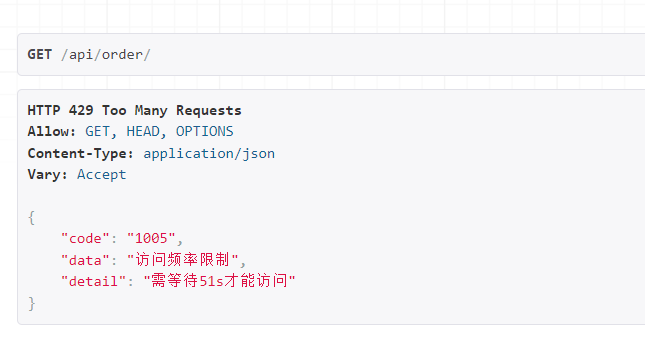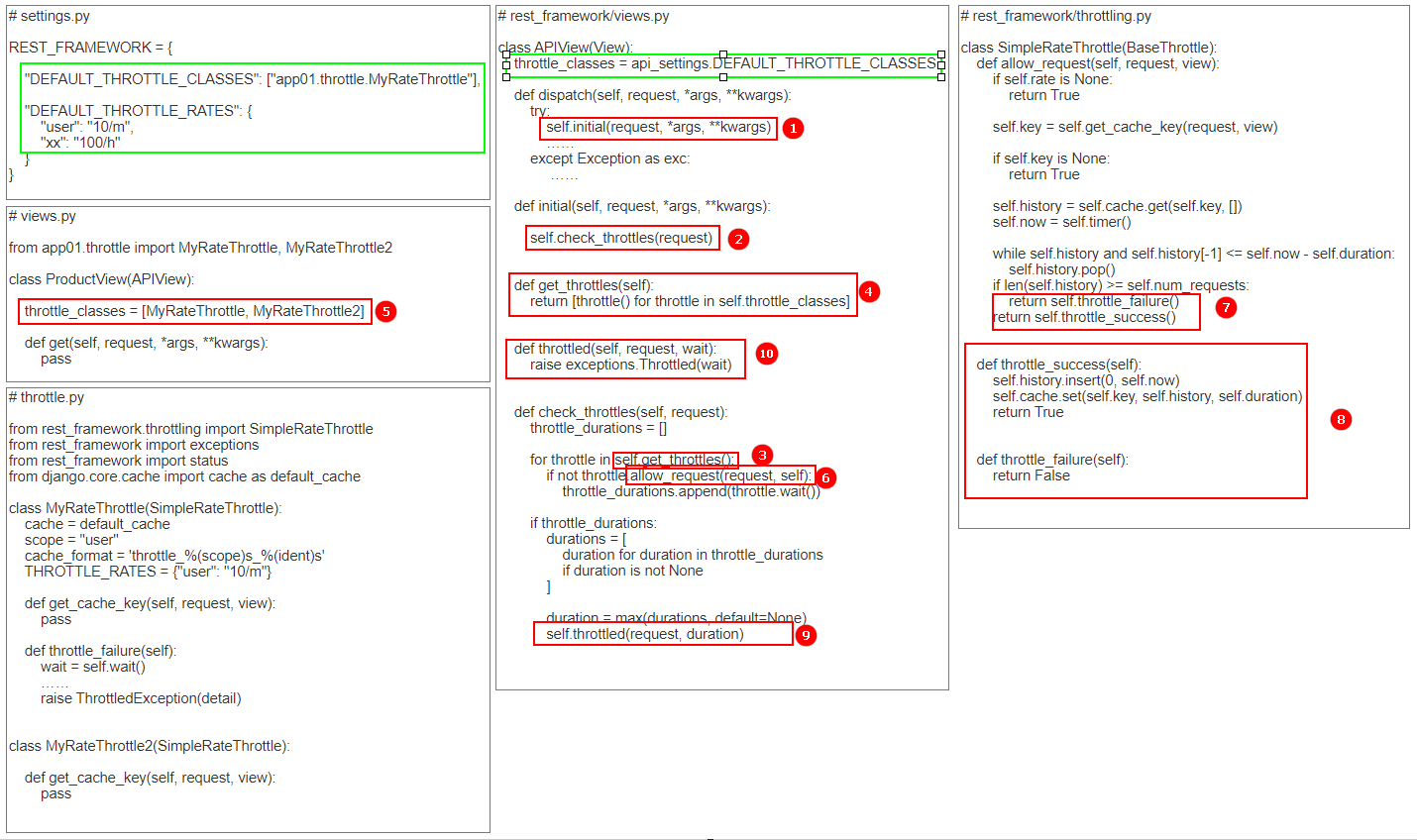一、限流组件介绍 1. 限流功能简介 1.1 限流的作用 为了对用户的访问行为进行限制,例如普通用户和会员用户对同一接口允许访问的次数不一样,或避免用户恶意压测接口对服务进行攻击,后台提供的 API 接口应当对用户进行限流。
1.2 限流功能实现的原理
第一步,后台会对访问的用户进行一个身份标识
对于匿名用户(未登录),使用用户 IP 作为唯一标识
对于登录用户,使用用户 ID 或名称作为唯一标识
第二步,后台将用户每次访问的时间都记录到缓存之中
1 2 3 4 5 6 7 {"127.0.0.1" : ["13:00:00" , "12:30:23" , "12:00:00" , "11:10:58" ]"cdc" : ["13:00:00" , "12:30:23" , "12:00:00" , "11:10:58" ]
第三步,根据限流规则进行判断,例如假设限流规则为 10次/小时,后台会将本次用户访问的时间作为开始时间,向前倒退一小时的时间作为截止时间,从缓存中将该用户在截止时间之前的记录都删除,判断剩下的记录数量是否已经达到上限,若未达到则允许访问
2. 限流组件的使用 2.1 限流信息缓存配置 用户访问记录存放的缓存载体种类可以有很多种,一般都是使用 redis 缓存(本机上要先安装 redis 并启动):
1 pip install django-redis ==4 .*
1 2 3 4 5 6 7 8 9 10 11 12 "default" : {"BACKEND" : "django_redis.cache.RedisCache" ,"LOCATION" : "redis://127.0.0.1:6379" ,"OPTIONS" : {"CLIENT_CLASS" : "django_redis.client.DefaultClient" ,"PASSWORD" : "123456" ,
2.2 编写限流类 限流类必须继承 rest_framework.throttling.SimpleRateThrottle 类,必须实现 get_cache_key 方法
1 2 3 4 5 6 7 8 9 10 11 12 13 14 15 16 17 18 19 20 21 22 23 24 25 26 27 28 29 30 31 32 33 34 35 36 37 38 39 40 41 42 43 44 45 46 47 48 49 50 51 52 53 54 55 56 57 58 59 60 61 62 63 64 from rest_framework.throttling import SimpleRateThrottlefrom rest_framework import exceptionsfrom rest_framework import statusfrom django.core.cache import cache as default_cacheclass ThrottledException (exceptions.APIException):""" 用于定义限流后返回的错误码 这个类可以不用写 """ 'throttled' class MyRateThrottle (SimpleRateThrottle ):"user" 'throttle_%(scope)s_%(ident)s' "user" : "10/m" }def get_cache_key (self, request, view ):""" 针对访问的用户构造一个标识(键),存放在缓存中 :param request: :param view: :return: """ if request.user:else :self .get_ident(request)return self .cache_format % {'scope' : self .scope, 'ident' : ident}def throttle_failure (self ):""" 定义用户被限流后返回的错误信息 :return: """ self .wait()"code" : 1005 ,"data" : "访问频率限制" ,'detail' : "需等待{}s才能访问" .format (int (wait))raise ThrottledException(detail)
2.3 路由 1 2 3 4 5 6 7 8 from django.urls import pathfrom app01 import views'api/order/' , views.ProductView.as_view()),
2.4 编写视图类 1 2 3 4 5 6 7 8 9 10 11 12 13 14 15 from rest_framework.views import APIViewfrom rest_framework.response import Responsefrom app01.throttle import MyRateThrottleclass ProductView (APIView ):def get (self, request, *args, **kwargs ):"code" : 1000 , "data" : "访问成功" }return Response(ret_data)
2.5 限流校验 启动服务,连续访问路由 http://127.0.0.1:8000/api/order/ 10 次都可以拿到正常的后台响应,访问第 11 次时报错
2.6 限流组件的全局使用 1 2 3 4 5 6 7 8 9 10 11 12 "DEFAULT_THROTTLE_CLASSES" : ["app01.throttle.MyRateThrottle" ],"DEFAULT_THROTTLE_RATES" : {"user" : "10/m" ,"xxx" : "100/h"
二、多个限流类 1. 多个限流类的使用 和认证组件、权限组件一样,视图类也支持多个限流组件,多个限流类存放在视图类的 throttle_classes 中,按照顺序依次执行。
1 2 3 4 5 6 7 8 9 10 11 12 13 14 15 16 17 18 19 20 21 22 23 24 25 26 27 28 29 30 31 32 33 34 35 36 37 38 39 40 41 42 43 44 45 46 47 48 49 50 51 52 53 54 55 56 57 58 from rest_framework.throttling import SimpleRateThrottlefrom rest_framework import exceptionsfrom rest_framework import statusfrom django.core.cache import cache as default_cacheclass MyRateThrottle (SimpleRateThrottle ):"user" 'throttle_%(scope)s_%(ident)s' "user" : "10/m" }def get_cache_key (self, request, view ):if request.user:else :self .get_ident(request)return self .cache_format % {'scope' : self .scope, 'ident' : ident}def throttle_failure (self ):self .wait()"code" : 1005 ,"data" : "接口1访问频率限制" ,'detail' : "接口1需等待{}s才能访问" .format (int (wait))raise ThrottledException(detail)class MyRateThrottle2 (SimpleRateThrottle ):"xxx" 'throttle_%(scope)s_%(ident)s' "xxx" : "3/m" }def get_cache_key (self, request, view ):if request.user:else :self .get_ident(request)return self .cache_format % {'scope' : self .scope, 'ident' : ident}def throttle_failure (self ):self .wait()"code" : 1005 ,"data" : "接口2访问频率限制" ,'detail' : "接口2需等待{}s才能访问" .format (int (wait))raise ThrottledException(detail)
1 2 3 4 5 6 7 8 9 10 11 12 13 from rest_framework.views import APIViewfrom rest_framework.response import Responsefrom app01.throttle import MyRateThrottle, MyRateThrottle2class ProductView (APIView ):def get (self, request, *args, **kwargs ):"code" : 1000 , "data" : "访问成功" }return Response(ret_data)
2. 多个限流类的执行过程 存在多个限流类的情况下,每个限流类校验无非最终会有两种结果
限流类执行过程中报错,抛出异常。此时表示当前限流类校验未通过,后续的其他限流类也不再执行;
限流类执行过程未报错,校验完成会返回一个布尔值,如果返回结果为 False ,则将该限流类存放在一个全局的列表中,否则就不做任何操作;继续执行下一个限流类,根据返回结果重复上手步骤;当所有限流类都执行完,判断全局的列表中是否存在未通过的限流类,存在则会调用内部的一个 self.throttled 方法返回异常,但是往往 self.throttled 方法返回的信息比较简单,我们可以在视图类中重写该方法:
1 2 3 4 5 6 7 8 9 10 11 12 13 14 15 16 17 18 19 20 21 22 23 24 25 26 27 28 29 30 31 32 33 34 35 36 37 38 class MyRateThrottle (SimpleRateThrottle ):"user" 'throttle_%(scope)s_%(ident)s' "user" : "10/m" }def get_cache_key (self, request, view ):if request.user:else :self .get_ident(request)return self .cache_format % {'scope' : self .scope, 'ident' : ident}def throttle_failure (self ):return False class MyRateThrottle2 (SimpleRateThrottle ):"xxx" 'throttle_%(scope)s_%(ident)s' "xxx" : "3/m" }def get_cache_key (self, request, view ):if request.user:else :self .get_ident(request)return self .cache_format % {'scope' : self .scope, 'ident' : ident}def throttle_failure (self ):return False
1 2 3 4 5 6 7 8 9 10 11 12 13 14 15 16 17 18 19 20 21 22 from rest_framework.views import APIViewfrom rest_framework.response import Responsefrom app01.throttle import MyRateThrottle, MyRateThrottle2class ProductView (APIView ):def get (self, request, *args, **kwargs ):"code" : 1000 , "data" : "访问成功" }return Response(ret_data)def throttled (self, request, wait ):"code" : 1005 ,"data" : "访问频率" ,'detail' : "需等待{}s才能访问" .format (int (wait))raise ThrottledException(detail)
建议校验失败时还是直接在限流类中抛出异常,一旦当前的类校验失败了,后续的类再进行校验已经没有意义了。
三、限流组件源码分析 限流组件功能的实现可以通过源码简单剖析一下
第一步,还是通过视图类先走到 APIView 中的 dispatch 方法,执行里面的 self.initial ;
第二步,self.initial 里调用了一个 check_throttles 方法,权限组件的验证功能就是通过该方法实现的;
第三步,check_throttles 方法中,针对视图类中使用每一个限流类都进行了实例化,并调用实例化对象的 allow_request 方法,该方法用于返回校验的结果,返回值为布尔值。将返回值为 False 的结果存储在一个全局列表 throttle_durations 中,等所有的限流类都执行完成,检查列表内是否有值,有值则证明部分限流类认证未通过,调用 self.throttled 抛出异常;如果循环过程中,有一个类抛出异常了,则循环终止,逐层向上抛出异常;
allow_request 里实现了从缓存中读取当前用户访问记录,并判断是否达到限制条件的功能。

